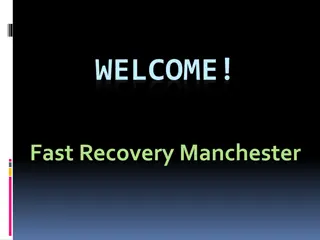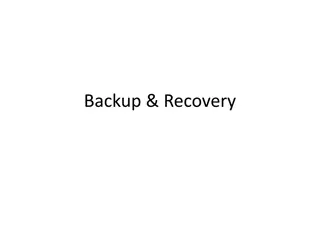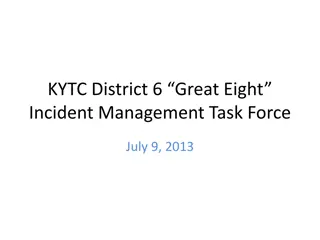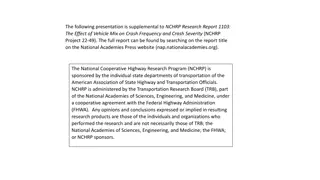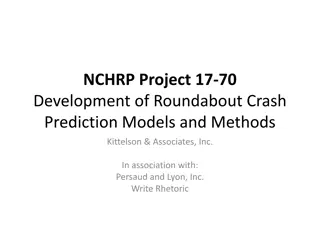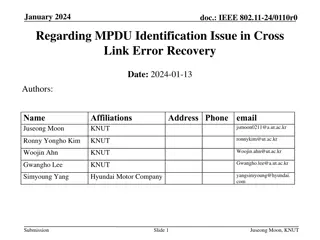Fast Crash Recovery in RAMCloud - Overview and Architecture
RAMCloud offers fast crash recovery, low-latency access, and large-scale storage in RAM, addressing the challenge of durability in RAM with a pervasive log structure and disk-based replication. The architecture includes Application Servers, Coordinators, Masters, Backups, and Storage Servers to ensure high performance, availability, and cost-efficiency.
Uploaded on Sep 07, 2024 | 0 Views
Download Presentation

Please find below an Image/Link to download the presentation.
The content on the website is provided AS IS for your information and personal use only. It may not be sold, licensed, or shared on other websites without obtaining consent from the author. Download presentation by click this link. If you encounter any issues during the download, it is possible that the publisher has removed the file from their server.
E N D
Presentation Transcript
Fast Crash Recovery in RAMCloud Diego Ongaro, Stephen M. Rumble, Ryan Stutsman, John Ousterhout, and Mendel Rosenblum Stanford University 1
Overview RAMCloud: General purpose storage in RAM Low latency: 5-10 s remote access Large scale: 10,000 nodes, 100 TB to 1 PB Key Problem: RAM s lack of durability Durability: Pervasive log structure, even in RAM Uses inexpensive disk-based replication RAM performance by eliminating synchronous disk writes Availability: Fast crash recovery in 1 to 2 s Recovers 35 GB to RAM in 1.6 s using 60 nodes Leverages the scale of the cluster Balances work evenly across hosts Avoids centralized control 2
RAMCloud Architecture Up to 100,000 Application Servers App App App App Library Library Library Library Coordinator Datacenter Network Masters expose RAM as Key-Value Store Master Master Master Master Backup Backup Backup Backup Backups store data from other Masters Up to 10,000 Storage Servers 3
Durability & Availability Requirements Retain high performance Minimum cost, energy Replicate in RAM of other masters? 3x system cost, energy Still have to handle power failures 4
The RAMCloud Approach 1 copy in RAM Backup copies on disk/flash: durability ~ free! Problem: Synchronous disk writes too slow Pervasive log structure, even in RAM Problem: Data is unavailable on crash Fast Crash Recovery in 1 to 2 s Fast enough that applications won t notice 5
Durability with RAM performance Master write Backups 6
Durability with RAM performance Master write Backups 7
Durability with RAM performance Backups buffer update No synchronous disk write Master write Backups 8
Durability with RAM performance Backups buffer update No synchronous disk write Master Backups 9
Durability with RAM performance Backups buffer update No synchronous disk write Master Bulk writes in background Must flush on power loss Backups 10
Durability with RAM performance Backups buffer update No synchronous disk write Master Bulk writes in background Must flush on power loss In-memory Log Pervasive log structure Even RAM is a log Log cleaner Backups 11
Durability with RAM performance Backups buffer update No synchronous disk write Master Hashtable Bulk writes in background Must flush on power loss In-memory Log Pervasive log structure Even RAM is a log Log cleaner Hashtable, key location Backups 12
Fast Crash Recovery What is left when a Master crashes? Log data stored on disk on backups What must be done to restart servicing requests? Replay log data into RAM Reconstruct the hashtable Recover fast: 64 GB in 1-2 seconds Key to fast recovery: use system scale 13
Recovery without Scale Recovery Master Masters backed up to 3 Backups Each backup stores entire log Problem: Disk bandwidth 64 GB / 300 MB/sec Backups 210 seconds Solution: more disks (more backups) Crashed Master 14
Solution: Scatter Log Data Each log divided into 8MB segments Master chooses different backups for each segment (randomly) Segments scattered across all servers in the cluster Crash recovery: All backups read from disk in parallel 64 GB / (1000 backups * 100 MB/s/backup) = 0.6 seconds Recovery Master Crashed Master ~1000 Backups 15
Problem: Network bandwidth Second bottleneck: NIC on recovery master 64 GB / 10 Gbits/second 60 seconds CPU and memory bandwidth a limitation Solution: more recovery masters Spread work over 100 recovery masters 60 seconds / 100 masters 0.6 seconds 16
Solution: Partitioned Recovery Divide each master s data into partitions Recover each partition on separate Recovery Master Partitions based on key ranges, not log segment Eliminates need for idle, empty Recovery Masters Recovery Masters Crashed Master Backups 17
Partitioning During Recovery Backups receive a partition list at the start of recovery Backups load segments from disk and partition log entries Each recovery master replays only relevant log entries To Master Recovering a to m To Master Recovering n to z Partition Key Range a to m a d c j z r q p n to z z a r q d p c j Segment Segment 18
Issues Harnessing Scale Balancing work evenly Parallel work is only as fast as the slowest unit Avoiding centralized control Centralized control eventually becomes a bottleneck Nodes often work without perfect/global knowledge 19
Balancing Partitions Problem: Balancing work of each recovery master Recovery will be slow if a single Master is given Too much data Too many objects Solution: Profiler tracks density of key ranges Done locally on each master Balance size and number of objects per partition 20
Segment Scattering Backups Problem: Balancing time reading data across disks Recovery is slow if just one Backup is slow Solution: Use similar approach to [Mitzenmacher 1996] Master Choose candidate Backups randomly Select the best Minimize worst-case disk read time 21
Detecting Incomplete Logs Problem: Ensure entire log is found during recovery Centrally cataloging segments for each log expensive Solution: Self-describing log Masters record catalog of log segments in segments Coordinator talks to each Backup at start of recovery Finds most recent catalog Can detect if all copies of most recent catalog are lost 22
Experimental Setup Cluster Configuration 60 Machines 2 Disks per Machine (100 MB/s/disk) Mellanox Infiniband HCAs (25 Gbps, PCI Express limited) 5 Mellanox Infiniband Switches Two layer topology Nearly full bisection bandwidth Approx. for datacenter networks in 3-5 years 5.2 s round trip from 100 B read operations 23
How much can a Master recover in 1s? 400 MB 800 MB 24
How well does recovery scale? Crashed Master Recovery Master 600 MB 600 MB 6 Backups 25
How well does recovery scale? Crashed Master 2 Recovery Masters 1200 MB 600 MB 600 MB 12 Backups 26
How well does recovery scale? 20 Recovery Masters Crashed Master 600 MB 600 MB 600 MB 600 MB 600 MB 600 MB 600 MB 600 MB 600 MB 600 MB 11.7 GB 600 MB 600 MB 600 MB 600 MB 600 MB 600 MB 600 MB 600 MB 600 MB 600 MB 27 120 Backups
How well does recovery scale? 1 Recovery Master 6 disks: 600 MB/s Recovered: 600 MB 20 Recovery Masters 120 backups: 11.7 GB/s Recovered: 11.7 GB 28
How well does recovery scale? 1 Recovery Master 6 disks: 600 MB/s Recovered: 600 MB 20 Recovery Masters 120 backups: 11.7 GB/s Recovered: 11.7 GB Total recovery time tightly tracks straggling disks 29
Flash Allows Higher Scalability 60 Recovery Masters 120 SSDs: 31 GB/s Recovered: 35 GB 2x270 MB/s SSDs per recovery master (vs. 6x100 MB/s disks per recovery master) 30
Fast Recovery Improves Durability GFS (SOSP 03) 3-Copies on Disk RAMCloud with 1-Copy in RAM 2-Copies on Disk Assumptions: 2 failures/server/year Failures are independent Failures lose all contents of both RAM and disk Replication factor 3 31
Related Work Log-structured Filesystem (LFS) RAMCloud keeps log in-memory and on disk More efficient cleaner; cleans from RAM instead of disk memcached Apps must deal with backing store and consistency Reduced performance from misses, cold caches Bigtable + GFS Primarily disk based Scatters across disks for durability Bigtable uses a logging approach on GFS Stores indexes, eliminates need for replay on recovery 32
Conclusions Pervasive log structure Fast writes, inexpensive Fast crash recovery in 1 to 2 s Recovers 35 GB to RAM in 1.6 s using 60 nodes Leverages the scale of the cluster Potential Impact Easy to harness performance of RAM at scale 5-10 s access time 100 TB to 1 PB As durable and available as disk Enable a new class data-intensive applications 33
Questions? ramcloud.stanford.edu 34






